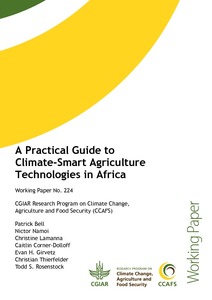A practical guide to climate-smart agriculture technologies in Africa
 Climate-smart agriculture (CSA) has been promoted since 2011 to increase productivity, improve resilience to climate variability and change and reduce greenhouse gas emission, where feasible, in farming systems globally and especially in Sub-Saharan Africa. CSA is unique, by comparison, to some other agricultural development approaches because it is outcome oriented, explicitly considers synergies and trade-offs among food and environment objectives and promotes solutions relevant to specific times and places. These advances however complicate CSA programming and investments. Such a flexible framework often leaves policy makers and program developers asking what is and what is not climate-smart? This guide provides a simple qualitative planning tool to help answer that question. With the information compiled here based on expert survey, users can conduct a rapid appraisal of the ‘climate-smartness’ of management practices and technologies. Specifically, users can explore suggested management practices and technologies based on climate risks they address, constraints to adoption and potential impacts on productivity, resilience and mitigation when changing management of cereal-, paddy rice-, tree-, livestock- and fish-based systems. These three characteristics of risks, constraints and outcomes represent a minimum level of information to consider when deciding whether a technique is climate-smart or not and potential concerns or opportunities. The document concludes with a compilation of technical manuals and extension guides on practices to provide user instructions on implementing technologies in the field.
Climate-smart agriculture (CSA) has been promoted since 2011 to increase productivity, improve resilience to climate variability and change and reduce greenhouse gas emission, where feasible, in farming systems globally and especially in Sub-Saharan Africa. CSA is unique, by comparison, to some other agricultural development approaches because it is outcome oriented, explicitly considers synergies and trade-offs among food and environment objectives and promotes solutions relevant to specific times and places. These advances however complicate CSA programming and investments. Such a flexible framework often leaves policy makers and program developers asking what is and what is not climate-smart? This guide provides a simple qualitative planning tool to help answer that question. With the information compiled here based on expert survey, users can conduct a rapid appraisal of the ‘climate-smartness’ of management practices and technologies. Specifically, users can explore suggested management practices and technologies based on climate risks they address, constraints to adoption and potential impacts on productivity, resilience and mitigation when changing management of cereal-, paddy rice-, tree-, livestock- and fish-based systems. These three characteristics of risks, constraints and outcomes represent a minimum level of information to consider when deciding whether a technique is climate-smart or not and potential concerns or opportunities. The document concludes with a compilation of technical manuals and extension guides on practices to provide user instructions on implementing technologies in the field.
